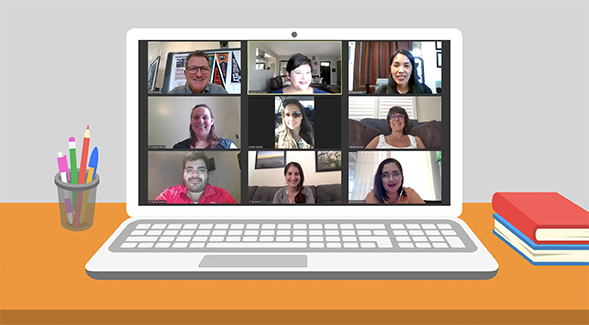Ahead of the Curve: SDSU Educators Anticipated the Virtual Classroom
Long before the COVID-19 pandemic necessitated it, SDSUs College of Education was on the forefront of preparing future teachers for the online realm.

“I've been able to apply a lot of what I'm learning in the class to what I'm doing as a teacher.”
Natasha Sebestyen remembers the feeling of shock. It was March 13 and the first wave of the COVID-19 outbreak was about to crest in the U.S.
An instructional assistant in a second and third grade combined class in Irvine, Sebestyen checked her email to find a clear message from her school district: Get ready to send your students home with all their things. There will be no school for at least three weeks.
“It was a little scary, I'm not going to lie," she said. “We had half an hour to get the kids all their books, all their supplies, all their materials.”
A couple of weeks later, another district email provided a second jolt.
“We were basically given three days to take everything that we were supposed to be doing in class and transition it to an online model,” Sebestyen said. “This was Monday and the kids were coming back virtually on Thursday — we had to have everything ready to go.”
Sebestyen and her co-teacher persevered and made it work. But it would have certainly helped to have known then what she’s learning now as a student in San Diego State University’s online Master of Arts in Teaching (MAT) in Elementary Education and Secondary Education program. Included in the course load is a brand new class centered on K-12 virtual teaching.
“The nation had a problem in the spring with the rapid shift to online instruction,” said Eric Ginsberg, a School of Teacher Education (STE) lecturer and advisor for the online MAT. “Many parents felt their students weren't engaged or supported. The question is now, what does great K-12 education look like in virtual spaces?
“SDSU's online MAT has been preparing teachers to take online student learning to the next level — ahead of online instruction taking center stage in K-12 schools.”
Impeccable Timing
The timing of the online MAT’s new course is certainly fortuitous, given the nationwide leap to virtual learning necessitated by the pandemic. But don’t think it’s a reaction to the crisis. Groundwork for the new component was laid last year by STE professor Valerie Pang — who founded the program in 2014 with the support of College of Education instructional designer Andrea Saltzman Martin and STE professor Luke Duesbery.
“We knew it was the future,” Duesbery said. “San Diego Unified already had three schools that were 100% online. So Val and I thought, ‘Let's teach people how to do it and get the best people out there to teach these classes.’ (STE director) Lynne Bercaw actually pushed us when we presented the idea. She said, ‘I want this right away and I want you to do it right now.’”
The inaugural course is being co-taught by lecturers Liz Buffington and Rick Selby, both experts in digital pedagogy. Splitting the online MAT’s cohort of about 70 students into two sections, they follow an “understand by design” approach where they have students think about desired outcomes first, then work out how to get there.
“Our mantra is, ‘The learning is first and the tools are second,’” Selby said. “We want them thinking about the why. And then we'll give them a lot of options to try to see what does and doesn't work for them.”
Added Buffington: “While we are meeting our MAT students' unique needs as educators in the field, we model and provide the opportunity for them to collaborate on what it looks like to provide learner-centered learning opportunities.”
The main project for the course is to create a website embedding all the tools that will help them deliver their lesson plan. The idea, Selby said, is to build a product that the MAT students — many of whom are already teachers — can start to use in their own classrooms.
In the first few weeks of the semester, the course has already helped Sebestyen master screencasting (digitally-recorded and narrated playback of computer screen output) and learning management systems (such as Canvas and Blackboard) — and utilize these tools in ways that make content fully accessible to all students.
“It's been really great so far,” Sebestyen said. “I've been able to apply a lot of what I'm learning in the class to what I'm doing as a teacher. I've taught nearly an entire unit of first grade math through screencasting.”
Quick Ascent
In just six years, SDSU’s online MAT has grown fast in both enrollment — it added a second cohort in 2019 — and national recognition. The program is an integral part of SDSU’s No. 8 ranking in U.S. News & World Report for online education master’s programs.
Part of the program’s success lies in the fact that the innovative curriculum pulls technology, pedagogy, critical thinking, equity and a focus on cultural and linguistic diversity under one digital tent. More virtual technology courses are planned for the future, Duesbery said, and the faculty are also exploring the possibility of branching out into a virtual teaching certificate program.
Another selling point is the fact that most teachers can complete the 24-unit program in one year, instead of the two-year commitment required by many programs at other universities. Students take four courses in the summer, and two apiece in the fall and spring.
For Sebestyen, still co-teaching in Irvine while she works towards her master’s, that has made all the difference.
“San Diego State was affordable, it was flexible and the classes looked really great in the catalog,” Sebestyen said. “Plus I'll be getting my master's in a year, which is almost unheard of. Then I'll get to market myself as a teacher who has a master's degree — and the pay stipend for a master's degree is pretty nice.”



